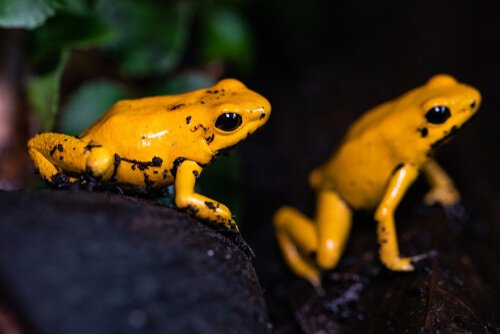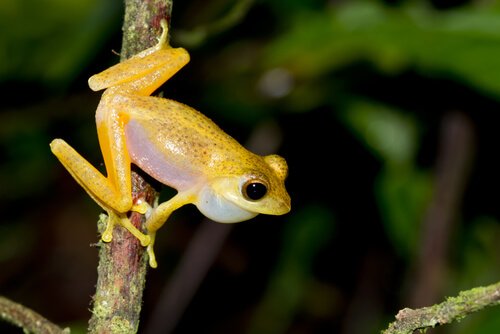Meet the Golden Frog

When you think of poisonous animals, the first ones that probably come into your head are snakes or spiders. However, there are also some frog species with this ‘ability.’ One example is the golden frog, also known as the golden dart frog, which is endemic to Colombia. Want to know more about it? Read on!
The golden frog: characteristics and habitat
These amphibians belong to the anuran group and are considered the most toxic vertebrates in the world. It lives in the humid jungles of Colombia and in the jungle region of Panama. It prefers rainy areas that are up to 200 meters above sea level with temperatures of at least 26 degrees Celsius and humidity of more than 80%.
As for its physical characteristics, the golden frog can reach 55 millimeters long when it’s an adult. It has ‘adhesive discs’ on its legs that help it climb between plants. Also, they have something similar to ‘teeth’ in their lower jaw, something that makes it different from other frogs, even those in the same habitat.
Its body is bright and very eye-catching. It’s almost completely yellow, similar to other species in its poisonous family. Some of them also have black spots and bulging, dark eyes.
The golden frog’s diet and reproduction
This amphibian’s diet is composed mainly of two different ant species. It may also eat other insects that live in the forest’s humid soils, like crickets, beetles, flies or termites.

As for its reproduction, and unlike other animals, the golden frog matures sexually when it reaches a certain size, rather than age. When mating, the male will make noises near the female. She will lay 15 eggs under a leaf and wait for a male to fertilize them. After that, he’s responsible for watching them and ensuring they’re kept moist.
After 12 days, the eggs will hatch and the tadpoles will ride on their father’s back until they complete their metamorphosis.
The golden frog’s poison
Although it’s small and may seem helpless, the truth is that this frog’s poison can kill up to 10 people. A milligram of its poison would kill at least 10,000 mice or two African elephants.
This frog’s skin is covered with an alkaloid called batrachotoxin. As soon as this touches its prey, then their victim’s muscles will contract and it’ll die from cardiac arrest.
The substance will still remain poisonous outside of the frog’s body. Because of this, some autochthonous tribes use this substance on their arrows.

There are three birds from Papua New Guinea and some frogs from the Dendrobates genus that have the same type of poison as these frogs. However, they have smaller quantities of it and their poison is less toxic than that of the golden frog.
A poisonous frog as a pet?
Due to its small size and striking color, many people choose to have a golden frog as a pet. This definitely sounds strange since they’re such a toxic species.
However, these frogs aren’t poisonous in captivity. This is basically due to the fact that their diet changes. Since you’re feeding them fruit flies and crickets, they’re not ingesting the necessary toxin that makes their skin deadly.
If you want to have this type of frog as a pet, you’ll have to meet certain requirements beyond its diet. For example, you should keep its tank around 20 degrees Celsius all year round. Also, make sure to keep it wet using sprinklers or other devices made for this.
Also, you’ll have to put stones, twigs or branches in its tank so it can climb, as well as leaves and plants where it’ll be able to hide. The idea is to replicate the tropical jungle that is its natural habitat.
All cited sources were thoroughly reviewed by our team to ensure their quality, reliability, currency, and validity. The bibliography of this article was considered reliable and of academic or scientific accuracy.
Zippel, K. C., Ibáñez, R., Lindquist, E. D., Richards, C. L., Jaramillo, C. A., & Griffith, E. J. (2006). Implicaciones en la conservación de las ranas doradas de Panamá, asociadas a su revisión taxonómica. Herpetotropicos. http://doi.org/10.3758/s13428-010-0044-x